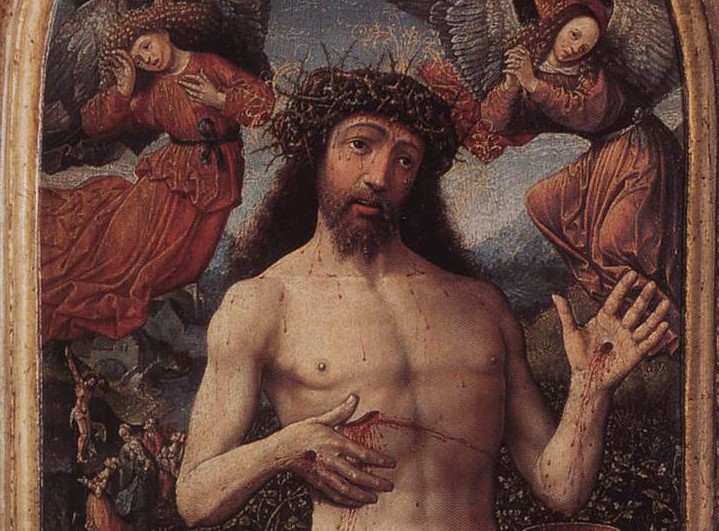Why Did Christ’s Glorified Body Still Have Wounds?
Several of the Resurrection accounts stress that Jesus showed the disciples His wounds. On one level we can understand that He was trying to make clear to them that the same Christ who was crucified stood before them; He was not a ghost or an apparition or simply someone who looked like Jesus.
When Christ rose, He took up His same, true body, but it now manifested a perfected glory. When we rise on the last day, the same will be true of our bodies. Why, then, were Christ’s wounds visible in His glorified body? Are not wounds and scars inconsistent with a glorified body?
St. Thomas Aquinas provides five reasons that Christ’s wounds are fitting in His glorified body. His reflections, from the Summa Theologiae III, Q. 54, Art. 4, are beautiful and poignant. St. Thomas’ words are presented below in bold, black italics, while my remarks appear in red text.
It was fitting for Christ’s soul at His Resurrection to resume the body with its scars. In the first place, for Christ’s own glory. For Bede says on Luke 24:40 that He kept His scars not from inability to heal them, “but to wear them as an everlasting trophy of His victory.” Hence Augustine says (De Civ. Dei xxii): “Perhaps in that kingdom we shall see on the bodies of the Martyrs the traces of the wounds which they bore for Christ’s name: because it will not be a deformity, but a dignity in them; and a certain kind of beauty will shine in them, in the body, though not of the body.”
Christ’s wounds are a dignity not a deformity, a sign of love not of loss, an indication of obedience not of onerousness. Through His wounds the Lord can say, “Here is what the world did to me, yet I live. Here is the cost of your redemption and the lavishness of my love.”
Secondly, to confirm the hearts of the disciples as to “the faith in His Resurrection” (Bede, on Luke 24:40).
This is what theologians refer to as “continuity.” The wounds demonstrate that the body that died on the cross is the same one the disciples see standing before them. Jesus has not taken up or fashioned a new body or a similar one; He is truly risen. The Greek word for resurrection is anastasis, which literally means “to stand again.” The word “resurrection” means the same thing: re (again) + surrexit (he stands). None of this would be true if a different body were before them, no matter how similar. Thus, Christ’s wounds confirm the truth of the resurrection.
Thirdly, “that when He pleads for us with the Father, He may always show the manner of death He endured for us” (Bede, on Luke 24:40).
Beautiful! The picture here is of the Son, Jesus, showing His wounds to His Father and saying, “See how I have loved them, Father. Have mercy on them.”
The Book of Hebrews says, Consequently, Jesus is able to save to the uttermost those who draw near to God through him, since he always lives to make intercession for them. For it was indeed fitting that we should have such a high priest, holy, innocent, unstained, separated from sinners, and exalted above the heavens. He has no need, like those high priests, to offer sacrifices daily, first for his own sins and then for those of the people, since he did this once for all when he offered up himself (Heb 7:25-27).
Fourthly, “that He may convince those redeemed in His blood, how mercifully they have been helped, as He exposes before them the traces of the same death” (Bede, on Luke 24:40).
To those who doubt the Lord’s love or His understanding of our trials, Christ’s wounds speak tenderly and clearly of His love and of the price He was willing to pay for us. His wounds are more eloquent testimony than any words could be. Is God merciful? Does God understand or care at all about our condition? Look to the wounds of Christ; dwell in them; take shelter in them.
Lastly, “that in the Judgment Day He may upbraid them with their just condemnation” (Bede, on Luke 24:40). Hence, as Augustine says (De Symb. ii): “… So will [Christ] show His wounds to His enemies, so that He who is the Truth may convict them, saying: ‘Behold the man whom you crucified; see the wounds you inflicted; recognize the side you pierced, since it was opened by you and for you, yet you would not enter.’”
Such powerful and moving word, in this case from St Augustine. There is also a refutation of the idea that God is simply harsh on Judgment Day. In effect, He will say, “I endured suffering from you out of love for you. When I was on the cross, the soldier pierced my side. My heart was literally opened for you and still you would not enter. What more could I have done than to allow your own sins to be your redemption? Still you refused.”
In spite of receiving lifelong graces and unmerited favors and blessings, in spite of God’s call echoing in their depths, many still refuse God’s offer. It is a tragedy that some hearts are so hardened. Christ’s wounds testify to the justice of God’s only (and final) recourse: allowing them to live apart from Him. Accepting the choice of their free will, God’s last act is simply to recognize their refusal and say, “you would not enter.”
Dwell in the wounds of Christ.
